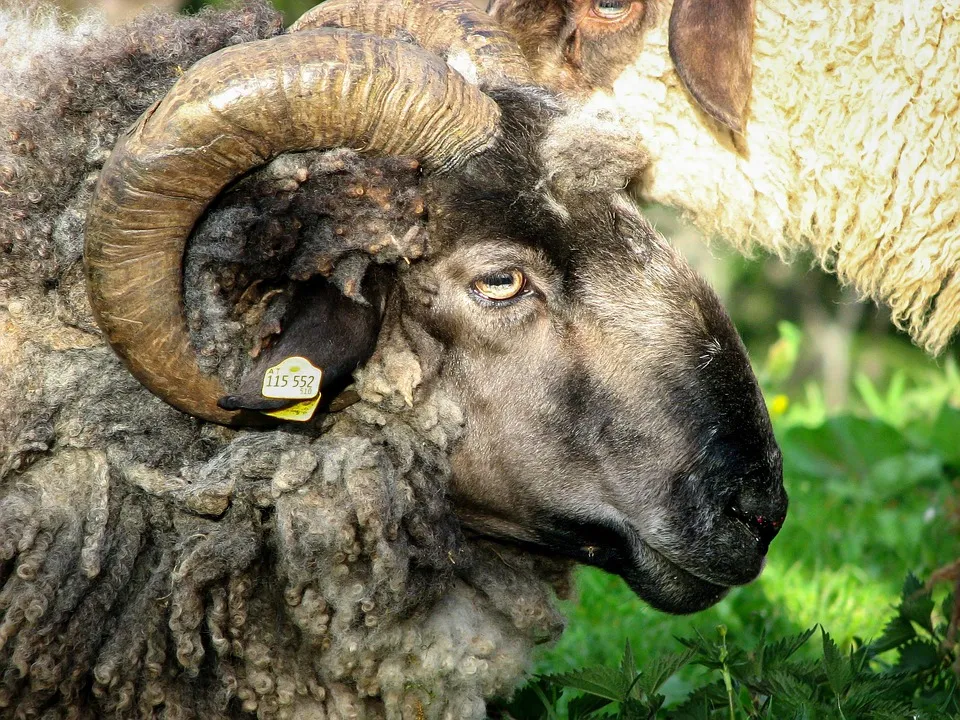Throughout the Bible, sheep play a pivotal role as a symbol of purity, sacrifice, and spiritual redemption. Both the Old and New Testaments make extensive use of this pastoral imagery and while much is known about sheep, their symbolic significance is often overlooked. In this article, we will explore the spiritual meaning of sheep in Scripture and delve deeper into their significance as a symbol of faith, obedience, and meekness.
The Use of Sheep in the Old Testament

In the Old Testament, sheep were a prevalent livestock animal, commonly used for their wool, milk, and meat. The Hebrew word for sheep is “tson” or “son,” which appears over 500 times throughout the Old Testament.
Sheep were a crucial part of daily life for the Israelites and were routinely featured in the biblical stories. Abel was the first person in the Bible to offer a sacrifice to God, and he offered a lamb, which was sacrificed as a sin offering. Moses and Aaron sacrificed rams as a part of their ordination ceremony as the high priest and priest, respectively.

The book of Exodus recorded that God instructed the Israelites to sacrifice a lamb and spread its blood on the doorposts as a sign for Him to pass over them in the last plague in Egypt. In Leviticus, sheep were a common animal for sacrificial offerings, and their meat was used in many holy feasts and celebrations.
King David was a shepherd before he became a king, and the book of Psalms often uses pastoral imagery of sheep and shepherds to describe his relationship with God. In Isaiah and Jeremiah’s prophecies, sheep were used as a symbol of Israel’s righteousness and obedience to God’s will.
Overall, in the Old Testament, sheep were an essential part of religious rituals and daily life. They were used as offerings and symbols of obedience and righteousness to God and His laws.
The Symbolic Significance of Sheep in the New Testament
In the New Testament, the symbolism of sheep takes on an even more powerful meaning. The concept of the good shepherd is introduced, with Jesus often referred to as the Good Shepherd who watches over and cares for his flock. This imagery draws on the pastoral tradition in the Old Testament, where the shepherd was a common symbol of leadership and guidance.
Jesus often used sheep and shepherding in his parables, illustrating his teachings through relatable, everyday experiences. One such parable is the story of the lost sheep, where a shepherd leaves his flock of 99 to search for the one sheep that went astray. This parable teaches the importance of forgiveness and redemption, as well as the value of every individual, no matter how lost they may seem.
The Passover feast is another significant place where sheep are mentioned in the New Testament. During the Passover, families would sacrifice a lamb and use its blood to symbolize protection from the plagues that struck Egypt in the time of Moses. This event foreshadows the ultimate sacrifice that Jesus made when he died on the cross to redeem humanity’s sins.
The symbol of sheep in the New Testament also represents qualities like meekness, obedience, and purity. Jesus refers to his followers as his flock, and he exhorts them to be meek and pure in heart. The imagery of sheep being led by their shepherd also emphasizes the importance of following Jesus and submitting to his authority.
Overall, the symbolism of sheep in the New Testament points towards the concepts of redemption, forgiveness, and submission to a higher power. Through the parables of Jesus and other references to sheep in scripture, we gain a deeper understanding of what it means to be a follower of Christ and live a life of faithfulness and obedience.
The Role of the Good Shepherd in Biblical Imagery
Throughout the Bible, sheep are used as a metaphor for God’s people, and the role of the shepherd is taken up by both God and Jesus. The image of the shepherd is one of pastoral care and guidance, emphasizing the love that God has for us and his desire for us to follow him.

Here are some key points to keep in mind when understanding the role of the shepherd in biblical imagery:
-
God is the ultimate shepherd. In the Old Testament, we see several examples of God as the shepherd to his people, Israel. In Psalm 23, for example, David writes “The Lord is my shepherd; I shall not want.” This passage speaks to the idea that God provides for his people and cares for them as a shepherd would for his flock.
-
Jesus is the good shepherd. In the New Testament, Jesus takes on the role of the shepherd, particularly in the gospel of John. Jesus describes himself as the good shepherd who lays down his life for his sheep (John 10:11). This passage emphasizes the sacrificial nature of Jesus’ death and his love for his followers.
-
The shepherd metaphor emphasizes God’s care for us. In both the Old and New Testament, the image of the shepherd emphasizes God’s love and care for his people. Just as a good shepherd will go to great lengths to protect and care for his flock, God will do the same for his followers.
-
The role of the shepherd extends to church leaders. In the letter to the Ephesians, Paul writes that God “gave some to be apostles, some prophets, some evangelists, and some pastors and teachers” (Ephesians 4:11). These church leaders are meant to serve as shepherds for their congregations, caring for and guiding them as a shepherd would for his flock.
Understanding the role of the shepherd in biblical imagery is important for understanding the deeper spiritual meaning of sheep in scripture. By recognizing God and Jesus as the ultimate shepherds and leaders, we can gain a greater sense of the love and care God has for us. Additionally, we can recognize the sacrificial nature of Jesus’ death and the call to follow and serve God as his sheep.
Overall, the role of the shepherd emphasizes the need for care, guidance, and love in our spiritual lives, and serves as a powerful metaphor for the depth of God’s love and care for his people.
Here is a summary list of key points:
- God is the ultimate shepherd in the Old Testament.
- Jesus is the good shepherd in the New Testament.
- The shepherd metaphor emphasizes God’s care for us.
- Church leaders serve as shepherds for their congregations.
Parables of Jesus Involving Sheep
Jesus frequently used sheep in his parables to teach important lessons about spiritual truths. One of the most well-known of these parables is the story of the lost sheep, found in both Matthew 18:12-14 and Luke 15:3-7.
In this story, Jesus compares himself to a shepherd who has 100 sheep. When one of the sheep becomes lost, the shepherd leaves the 99 other sheep behind to search for the one that is lost. When he finally finds the lost sheep, he rejoices and celebrates that it has been found. In this parable, Jesus is showing how much he cares for each and every person, even if they have wandered away from their faith.
« The Essential Guide to Usher Ministry in the Church
Discovering the Heart of Jesus: His Unconditional Love for Sinners »
Another parable involving sheep is found in John 10:1-18, where Jesus talks about the role of the good shepherd. In this parable, Jesus says that he is the good shepherd who knows his sheep and is willing to lay down his life for them. He contrasts this with the actions of a hired worker who does not care for the sheep and might even abandon them if danger arises.
Through this parable, Jesus is illustrating the importance of having a personal relationship with him and the protection and care that he provides. He is also showing that he is willing to make the ultimate sacrifice for his followers, which he ultimately does through his death and resurrection.
These parables, along with many other references to sheep throughout the Bible, demonstrate the significant spiritual meaning associated with this animal. Sheep are often used to symbolize obedience and meekness, as well as the concepts of sacrifice and redemption. By understanding the deeper symbolic meaning of sheep, we can better understand the message that Jesus was trying to convey through his teachings and parables.
Sheep as a Symbol of Obedience and Meekness

Sheep have long been used as a symbol of obedience and meekness in the Bible. This goes back to the Old Testament, where sheep were seen as an important part of the daily life of the Israelites. They were used for their wool, their meat, and for sacrifices to God.
In the New Testament, Jesus often used sheep as an example of how we should live our lives. In John 10:11, Jesus says, “I am the good shepherd. The good shepherd lays down his life for the sheep.” This image of the shepherd caring for his flock shows us how God cares for us and wants us to care for each other.
Sheep are also used in the parables of Jesus as a way to teach about humility and obedience. In the parable of the lost sheep in Luke 15, Jesus tells the story of a shepherd who leaves his 99 sheep to search for the one sheep that is lost. This shows us that no one is too small or insignificant for God to care about and that we should be willing to go to great lengths to help those in need.
Another example of sheep representing meekness and obedience can be found in the book of Isaiah. In Isaiah 53:7, it says, “He was oppressed and afflicted, yet he did not open his mouth; he was led like a lamb to the slaughter, and as a sheep before its shearers is silent, so he did not open his mouth.” This verse is talking about the sacrifice of Jesus and how he was willing to lay down his life for us, even though he was innocent.
Overall, the symbolism of sheep in the Bible shows us the importance of obedience, meekness, and sacrifice. We are called to follow the example of the Good Shepherd and care for the people around us, even if it means sacrificing our own comfort or desires. By embracing the symbolism of sheep, we can cultivate a deeper sense of humility and obedience in our own lives and become more like Jesus.

Here are some key takeaways to remember about the symbolic significance of sheep in the Bible:
- Sheep are a symbol of obedience and meekness.
- Jesus used sheep as an example of how we should live our lives.
- We should be willing to care for others and make sacrifices, just as a shepherd cares for his flock.
- The sacrifice of Jesus is often associated with the image of a lamb or sheep.
- By embracing the symbolism of sheep, we can cultivate humility and obedience in our own lives.
The Concept of Sacrifice and Redemption in Sheep Symbolism
Throughout the Bible, sheep are often intimately tied to the idea of sacrifice and redemption. In the Old Testament, sheep were used as sacrifices for sin offerings and as a symbol for the people of Israel. This symbolism carried over into the New Testament, where Jesus is often referred to as the “Lamb of God” who was sacrificed for the sins of humanity.
One of the most well-known stories involving sheep as sacrifices is the story of Abraham and Isaac. In this story, God commands Abraham to sacrifice his son Isaac as a test of faith. Abraham, being a faithful follower of God, prepares to obey but at the last moment, God intervenes and provides a ram for the sacrifice instead. This story is not only a testament to Abraham’s faith but also shows the importance of sacrifice in acknowledging and repenting for sin.
In the New Testament, Jesus is described as the Good Shepherd, who lays down his life for his sheep. This imagery serves as a reminder of Jesus’ ultimate sacrifice on the cross for the redemption of humanity. Additionally, in the parable of the lost sheep, Jesus emphasizes the importance of finding and restoring those who have strayed from the flock.
The concept of redemption is also tied to sheep symbolism, with sheep representing purity and innocence. In the book of Isaiah, it is prophesied that the Messiah will be led like a lamb to the slaughter, representing Jesus’ sacrificial death for the forgiveness of sins. Similarly, in the book of Revelation, the Lamb is described as the only one worthy to break the seal and open the scroll, symbolizing the redemption of humanity through Jesus’ sacrifice.

As believers, we are called to emulate the characteristics of sheep, including meekness, obedience, and purity. This means acknowledging our own sinfulness and repenting for our wrongdoing, just as sheep are led to the shearer for their wool to be trimmed. By doing so, we can experience the redemption and forgiveness that is offered through Jesus’ sacrifice on the cross.
The symbolism of sheep in the Bible is a powerful reminder of the sacrifice and redemption that is available to all who believe. By understanding this symbolism and emulating the qualities of sheep, we can draw closer to God and grow in our faith.
Conclusion: Understanding the Deeper Spiritual Meaning of Sheep in Scripture
In conclusion, the symbolic significance of sheep in the Bible is powerful and multifaceted. Through the use of pastoral imagery, parables, and historical references, the Bible uses the symbol of sheep to convey messages of obedience, meekness, purity, redemption, and forgiveness.
As we have explored, the use of sheep in the Old Testament highlights their role in Jewish sacrifice and the idea of being a member of a flock. In the New Testament, sheep are associated with the Good Shepherd, who is often depicted as Jesus himself. Through this metaphor, we see the love and care that God has for his people, leading them to safety and providing for their needs.
The parables of Jesus that involve sheep, such as the lost sheep and the lamb that is carried by the Good Shepherd, illustrate how God values every single person and seeks to bring them back into the fold. At the same time, the symbolism of sacrifice and redemption associated with the Passover and other Jewish traditions is further exemplified through the image of the sacrificial lamb.

Sheep are also used to symbolize the character qualities of obedience and meekness. In many instances, sheep are described as being in submission to their shepherd, trusting him fully to guide them. This obedience is also tied to the idea of purity, as sheep are often depicted as being without blemish or defect.
Ultimately, the deeper spiritual meaning of sheep in scripture is one of redemption and forgiveness. As Jesus himself stated, he is the Good Shepherd who lays down his life for his sheep. Through his ultimate sacrifice, we are offered forgiveness and eternal life.
As believers, we can take comfort in these powerful symbols of sheep and the meanings they convey. May we trust in the Good Shepherd to guide us and lay down our lives in humble submission to his will.












